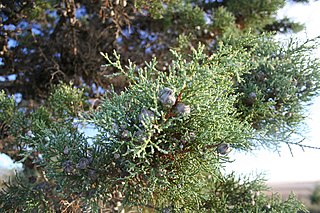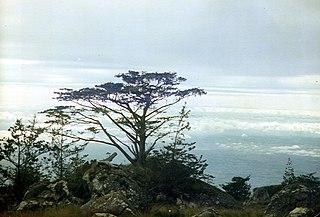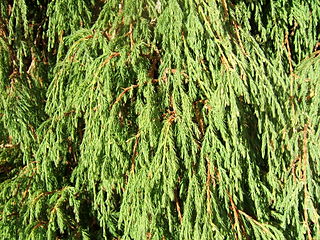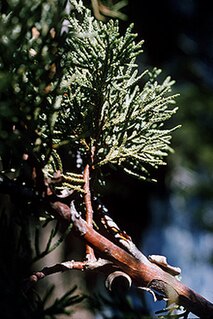
Juniperus indica, the black juniper, is a juniper native to high-altitude climates in the Himalaya, occurring in Pakistan, India, Nepal, Bhutan and China.

Callitris is a genus of coniferous trees in the Cupressaceae. There are 16 recognized species in the genus, of which 13 are native to Australia and the other three native to New Caledonia. Traditionally, the most widely used common name is cypress-pine, a name shared by some species of the closely related genus Actinostrobus.

Actinostrobus is a genus of coniferous trees in the Cupressaceae. Common names include cypress, sandplain-cypress and cypress-pine, the last of these shared by the closely related genus Callitris.

Juniperus oxycedrus, vernacularly called Cade, cade juniper, prickly juniper, prickly cedar, or sharp cedar, is a species of juniper, native across the Mediterranean region from Morocco and Portugal, north to southern France, east to westernmost Iran, and south to Lebanon and Israel, growing on a variety of rocky sites from sea level up to 1,600 metres in elevation. The specific epithet oxycedrus means "sharp cedar" and this species may have been the original cedar or cedrus of the ancient Greeks.

Tetraclinis is a genus of evergreen coniferous trees in the cypress family Cupressaceae, containing only one species, Tetraclinis articulata, also known as Thuja articulata, sandarac, sandarac tree or Barbary thuja, endemic to the western Mediterranean region. It is native to northwestern Africa in the Atlas Mountains of Morocco, Algeria, and Tunisia, with two small outlying populations on Malta, and near Cartagena in southeast Spain. It grows at relatively low altitudes in a hot, dry subtropical Mediterranean climate.

Widdringtonia is a genus of coniferous trees in the Cupressaceae. The name was Austrian botanist Stephan Endlicher's way of honouring an early expert on the coniferous forests of Spain, Capt. Samuel Edward Widdrington (1787–1856). There are four species, all native to southern Africa, where they are known as cedars or African cypresses.

Juniperus drupacea, the Syrian juniper, is a species of juniper native to the eastern Mediterranean region from southern Greece, southern Turkey, western Syria, and Lebanon, growing on rocky sites from 800–1,700 metres in altitude.

Callitris pancheri is a plant species of the family Cupressaceae. It is endemic to New Caledonia, where it occurs in small, scattered population along rivers. It used to be placed in its own genus Neocallitropsis but molecular phylogenetic analysis indicated that it was nested within Callitris.

Actinostrobus pyramidalis, commonly known as swamp cypress, Swan River cypress and King George's cypress pine, is a species of coniferous tree in the Cupressaceae. Like the other species in the genus Actinostrobus, it is endemic to southwestern Western Australia.

Juniperus recurva, commonly named the Himalayan juniper or drooping juniper, is a juniper native to the Himalaya, from northern Pakistan, through India, Nepal and Bhutan, to western Yunnan in southwestern China. It grows at altitudes of 3,000–4,000 metres.

Juniperus deppeana is a small to medium-sized tree reaching 10–15 metres, rarely 25 m, in height. It is native to central and northern Mexico and the southwestern United States. It grows at moderate altitudes of 750–2,700 m (2,460–8,860 ft) on dry soils.

Callitris columellaris is a species of coniferous tree in the family Cupressaceae, native to most of Australia. Common names include White Cypress-pine, Murray River Cypress-pine, and Northern Cypress-pine. Callitris columellaris has become naturalised in Hawaii and in southern Florida.
Actinostrobus acuminatus, commonly known as dwarf cypress, creeping pine or Moore cypress pine, is a species of coniferous tree in the Cupressaceae. Like the other species in the genus Actinostrobus, it is endemic to southwestern Western Australia, where it can be found along the shorelines of rivers. The Mount Henry Peninsula is an example of the environment in which this cypress is found. It shares the common name dwarf cypress with several other plants, and shares the name creeping pine with others.

Actinostrobus arenarius is a species of conifer in the cypress family, Cupressaceae. Its common names include sandplain cypress, Bruce cypress, Bruce cypress-pine, and tamin. It is endemic to Western Australia.

Callitris baileyi is a species of conifer in the family Cupressaceae. It is found only in Australia, more specifically Southeast Queensland. Its common English name is Bailey's cypress-pine. The name is dedicated to Australian botanist Frederick Manson Bailey, who was the first to collect specimens of this tree. Bailey's name is closely associated with much of the flora of Queensland and their elucidation in Southeastern Queensland. Over the past few decades the conifer has been severely threatened by habitat loss Fruiting for the species has been recorded year-round.

Juniperus brevifolia, the Azores juniper, is a species of juniper, endemic to the Azores, where it occurs at altitudes of 240–800 metres, rarely up to 1,500 m (4,900 ft). It is closely related to Juniperus oxycedrus of the Mediterranean region and Juniperus cedrus of the neighboring Macaronesian islands. It is threatened by habitat loss.

Juniperus pinchotii, commonly known as Pinchot juniper or redberry juniper, is a species of juniper native to south-western North America, in Mexico: Nuevo León and Coahuila, and in the United States: south-eastern New Mexico, central Texas, and western Oklahoma.

Juniperus rigida, the temple juniper, is a species of juniper, native to northern China, Mongolia, Korea, Japan, and the far southeast of Russia, occurring at altitudes of 10–2,200 metres (33–7,218 ft). The species is also naturalized in the United States. It is closely related to Juniperus communis and Juniperus conferta, the latter sometimes treated as a variety or subspecies of J. rigida.

Juniperus standleyi is a species of juniper native to Guatemala and the adjacent extreme southeast of Mexico, where it occurs at elevations of 3,000–4,250 metres. Its local common names include huitó, cipres, and huitum.
Juniperus taxifolia is a species of juniper, endemic to the Bonin Islands southeast of Japan.


















